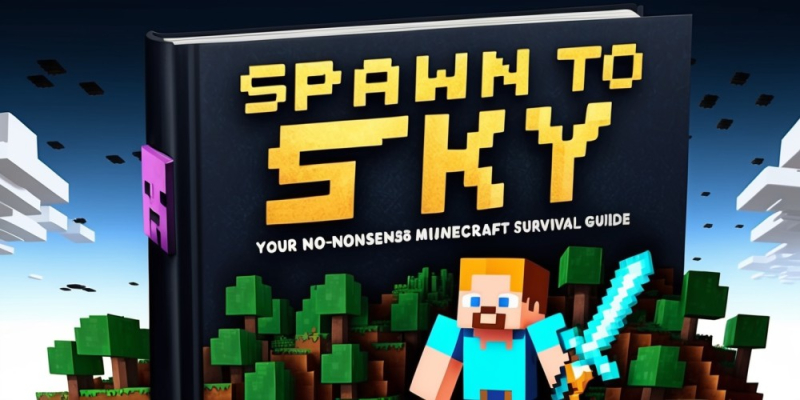Spawn to Sky: Your No-Nonsense Minecraft Survival Guide
2025-09-08

Want a fast, friendly path from wooden tools to flying with Elytra? This guide gives you a clear plan: what to craft, where to go, and how to win big fights — with simple steps you can follow today. It’s designed to be actionable and light, so you learn by doing.
You will set up your first base, mine smarter, trade for top gear, explore the Nether, beat the Ender Dragon, start useful farms, and build better homes. Ready to turn a fresh spawn into your favorite world? Let’s go.
Start Smart: Game Setup and Day-Zero Plan
World settings that help
- Mode: Survival to learn the core loop. Creative later for testing builds.
- Difficulty: Normal for balance. Easy to practice combat. Hard for a challenge.
- Coordinates: Turn on “Show Coordinates” (Bedrock) or use F3 (Java). Knowing your position saves time.
- Bonus Chest: Optional jumpstart if you want food and basic tools right away.
- Seed choice: Plains or Meadow starts are friendly. Desert and Jungle are harder for day one food.
Day-zero mindset
- Goals are small and clear: tools, food, light, shelter, and a bed.
- Play safe, not slow: a shield and torches will prevent most early deaths.
Day 1–2: A Simple Survival Routine
First 15 minutes
- Punch trees → Crafting Table → Wooden Pickaxe → 20+ cobblestone.
- Make Stone Pickaxe, Axe, Shovel, and a Furnace. Craft a Sword or use an Axe for combat.
- Collect food: murder 3 sheep for bed if possible; grab berries, apples, fish, or animals.
- Smelt logs into charcoal to craft torches if you do not find coal.
- Place torches around your work area. Darkness = mob spawns.
Shelter and safety
- Build a tiny hut or dig into a hill (3 blocks tall, door, torches inside).
- Craft a Bed (3 wool + 3 planks) and sleep to skip the night and set spawn.
- Shield early (6 planks + 1 iron) — it blocks skeleton arrows and creeper blasts.
Your first tools priority
- Iron Pickaxe to mine redstone, gold, and diamonds.
- Bucket (water saves you from fall and lava).
- Full Iron Armor as soon as possible for a big defense jump.
Mining 2.0: Ores, Y-Levels, and Methods
Smart mining rules
- Never dig straight down. Use stairs or a two-block drop method.
- Bring torches, food, extra pickaxes, a water bucket, and blocks.
- Place torches on the right as you go in; they’ll be on your left on the way out.
Where to find ores (1.18+ world generation)
- Coal: common high up and on cliffs; easy vision in mountains.
- Iron: found at many heights; extra common in mountain biomes and around mid-levels.
- Copper: mid-levels; good for building blocks and lightning rods.
- Lapis: around Y:0; harvest for enchanting.
- Gold: more common in badlands; deeper levels elsewhere.
- Redstone: very common deep underground.
- Diamonds: best near the bottom of the world; watch for lava lakes.
Mining methods that work
- Branch mining: a main tunnel with 2-block-spaced side branches for efficient ore exposure.
- Caving: explore natural caves; place torches often and block off risky areas.
- Fortune and Silk Touch: once enchanted, use Fortune on ore blocks, Silk Touch for moving ores or stone cleanly.
Gear Progression and Enchant Path
Armor and tools roadmap
- Iron set → Diamond set → Netherite upgrades for your best pieces.
- Priority pieces: Chestplate, Leggings, Helmet, then Boots.
- Always carry: water bucket, blocks, torches, food, extra pickaxe, and a bow with arrows.
Enchanting basics
- Enchanting Table: 4 obsidian, 2 diamonds, 1 book.
- Place 15 bookshelves around the table (one-block gap) to unlock level 30.
- Bring Lapis and XP (mining, smelting, and trading give levels).
Recommended enchants
- Armor: Protection (or specialized: Fire Prot, Blast Prot), Unbreaking, Mending.
- Sword/Axe: Sharpness or Smite, Looting, Unbreaking, Mending.
- Pickaxe: Efficiency, Unbreaking, Fortune; have a second with Silk Touch.
- Bow: Power, Infinity or Mending, Punch (optional), Flame (optional).
- Boots: Feather Falling is a lifesaver.
Villages, Trading Halls, and Your Early Economy
Why villagers matter
- They sell enchanted books, diamond tools and armor, and give easy emeralds.
- Set your base near a village or bring villagers to you with boats or minecarts.
Best early jobs
- Librarian (Lectern): reroll until you get Mending, Unbreaking, Efficiency, Fortune, or Silk Touch.
- Fletcher (Fletching Table): trades sticks for emeralds; logs → sticks → emeralds is fast income.
- Farmer (Composter): buys crops; easy cash from wheat, carrots, potatoes.
- Armorer/Toolsmith/Weaponsmith: sell high-tier gear for emeralds.
Trading hall tips
- Give each villager a bed and job block to keep them stable.
- Lock a good trade by buying once; then the villager keeps it.
- Light the area well and fence it to prevent zombie attacks.
Exploring Biomes and Structures Safely
Biomes to favor early
- Plains/Meadow: easy food, flat building area, often near villages.
- Taiga: lots of wood and berries; wolves help in combat.
- Coast/Ocean: shipwrecks and ruins offer treasure and maps.
Structures to target
- Villages: beds, crops, loot, and trades; great place for your main base.
- Shipwrecks: early iron, diamonds, and buried treasure maps.
- Ruined Portals: gold tools/armor and obsidian; sometimes enough to finish a Nether portal.
- Desert Temples: rich loot; disable the TNT by breaking the pressure plate.
- Mineshafts: chests, rails, and cave spider spawners (be careful: poison).
- Trial Chambers (1.21+): combat-focused dungeons with unique loot; go with good armor and plenty of food.
The Nether Roadmap
Portal and prep
- Create obsidian with water and lava or mine it with a diamond pickaxe.
- Frame interior is 2x3; light with Flint and Steel.
- Wear one piece of gold armor to avoid angering piglins.
Travel and safety
- One block in the Nether equals eight in the Overworld. Use portals for long-range travel.
- Carry blocks, a bow, a shield, and Fire Resistance potions if possible.
- Warped Forests are safer; avoid open lava seas and Basalt Deltas early.
Targets in the Nether
- Nether Fortress: blaze rods (brewing, Eyes of Ender) and nether wart (potion base).
- Bastion Remnant: big loot; go slow, watch piglin brutes, and block off routes.
- Ancient Debris: found deep; smelt to scraps and craft Netherite upgrades.
Potions That Make Fights Easy
How to brew
- Brewing Stand (blaze rod + cobblestone), water bottles, and blaze powder as fuel.
- Start with Awkward Potions (nether wart) then add an effect ingredient.
- Redstone dust extends duration; glowstone dust makes stronger, shorter effects.
Most useful potions
- Fire Resistance: almost mandatory for Nether trips.
- Healing and Regeneration: clutch for boss fights.
- Strength and Swiftness: faster, stronger, safer.
- Slow Falling: perfect for the End and tall builds.
- Water Breathing and Night Vision: ocean ruins and mining visibility.
The End: Stronghold, Dragon, and Elytra
Find the stronghold
- Craft Eyes of Ender from blaze powder and ender pearls.
- Throw an Eye, follow its direction, and dig carefully when it turns downward.
- Fill the End Portal frame with Eyes to open it (some frames may already have Eyes).
Dragon fight plan
- Bring bow with many arrows, water bucket, blocks, food, and Slow Falling potions.
- Break the end crystals first; shoot them or pillar up carefully.
- When the dragon perches, hit the head with melee; avoid the purple breath on the ground.
- After victory, a gateway spawns. Collect the dragon egg if you like.
End cities and Elytra
- Enter the small portal with an ender pearl (or build/bridge safely).
- Search for a city with a ship. The ship holds Elytra in an item frame.
- Farm shulkers for shells and craft shulker boxes (portable chests).
- Craft rockets (paper + gunpowder) for Elytra flight; use low power while learning.
Redstone Starter Pack and Useful Farms
Core components
- Redstone dust: carries power to devices.
- Levers, buttons, pressure plates: input controls.
- Hoppers: move items between inventories.
- Observers: detect block updates; great for automatic farms.
- Pistons and Sticky Pistons: move blocks for doors or machines.
Easy farms to build early
- Auto sugar cane: observer detects growth, pistons break, hopper collects.
- Villager crop farm: farmer villager harvests and shares food; collect with hoppers.
- Iron smelter array: several furnaces fed by hoppers to process ores fast.
- Mob farm (simple tower or ocean platform): bones, arrows, gunpowder for rockets.
- Wool farm: one sheep per module with shears in a dispenser; colored wool for building.
Building Better Bases
Plan, palette, and shape
- Pick a palette: 3–5 blocks that blend (oak, spruce, stone, andesite, copper).
- Block variety: slabs, stairs, fences, and trapdoors add depth to flat walls.
- Shape first: outline the roof and silhouette; add details after.
Function first layout
- Core room: bed, storage, crafting table, furnace/blast furnace, and anvil together.
- Safety ring: walls or fences, torches, and a lookout spot.
- Nether portal room: place away from animals and wood to avoid fire.
Light and decor
- Use lanterns and hidden lighting under carpets or leaves to stop spawns.
- Path blocks, leaves, and flower pots make exteriors feel finished.
- Armor trims and banners add personality to your gear and house.
Performance, Controls, and Accessibility
Run smoother
- Lower render distance and clouds if your FPS drops.
- Keep farms compact; spread big redstone builds away from your main base.
- Use Ender Chests to reduce item stacks in your inventory and lag from item drops.
Control tips
- Rebind keys so shield, food, and blocks are easy to reach.
- Use subtitles to spot lava, portals, and hostile mobs by sound direction.
- Practice hotbar cycling and block clutching with a water bucket.
Common Pitfalls and How to Dodge Them
- Skipping a shield: it is the best early defense. Craft it as soon as you have iron.
- Dark base: spam torches; one every few blocks indoors and on the perimeter.
- Carrying everything: leave backups at home; carry only what you need for the task.
- No escape plan: keep blocks and a water bucket on your hotbar at all times.
- Entering the Nether unprepared: bring gold armor and Fire Resistance.
- Ignoring villagers: a single Librarian with Mending changes the whole game.
14-Day Action Plan: Spawn to Elytra
- Day 1: Stone tools, food, torches, bed, tiny shelter, and a shield.
- Day 2: Iron tools and armor; start a wheat or potato farm; mark your base with a tall torch pillar.
- Day 3–4: Explore for a village; set up a Librarian (aim for Mending/Unbreaking) and a Fletcher.
- Day 5–6: Enchant at level 30; get Efficiency and Fortune on a pickaxe; expand food and animal pens.
- Day 7: Build a Nether portal; locate a fortress; collect blaze rods and nether wart.
- Day 8: Brew Fire Resistance, Healing, and Strength; gather ender pearls (trade or hunt at night/warped forest).
- Day 9: Craft Eyes of Ender; locate the stronghold; set a bed near the portal room.
- Day 10: Defeat the Ender Dragon; grab XP and open the End gateway.
- Day 11–12: Find an End City with a ship; get Elytra and shulker shells; craft shulker boxes.
- Day 13: Fly home; set up a basic mob farm for gunpowder and a sugar cane farm for rockets.
- Day 14: Start a trading hall, enchant full gear, and plan your first big build or automated farm.
Conclusion
Minecraft is a loop of small wins: gear up, light up, build up. With a shield, a safe base, smart mining, and villagers on your side, you will reach the End, find Elytra, and make a world that feels like home.
Keep learning one feature at a time. Try one new farm, one new block palette, or one new biome each session. That steady progress turns every world into your best adventure yet.
Quick Tips
- Shield, water bucket, and torches: never leave home without them.
- Trade early: Fletcher for emeralds, Librarian for Mending and Efficiency.
- Fire Resistance makes the Nether almost stress-free.
- Slow Falling and a bow make the Ender Dragon fight much easier.
- Use shulker boxes and Ender Chests to stay organized on long trips.
- Back up your world before risky builds and boss fights.




